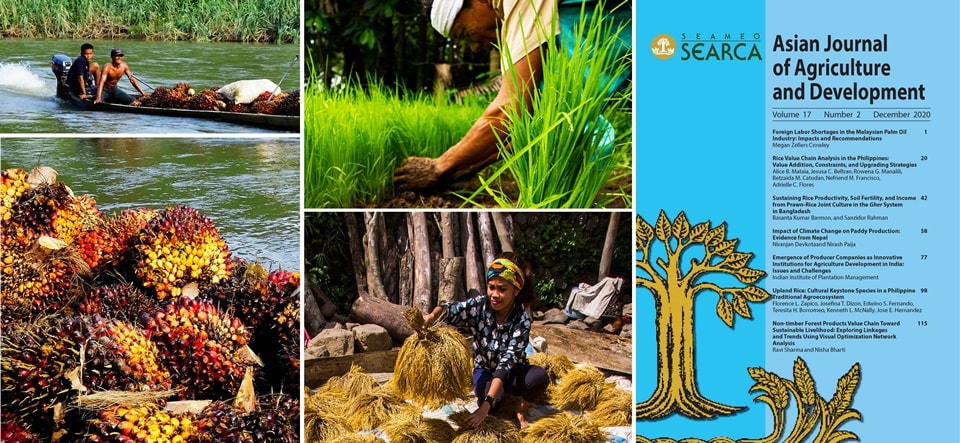The Asian Journal of Agriculture and Development (AJAD) releases its latest issue with studies examining two key crops in Asia, rice and palm oil, and recommending policies and practices to bolster the performance of these sectors.
Malaysia’s plantation industry and economy’s dependence on foreign labor can prevent optimum productivity by disincentivizing mechanization and innovation. The impacts of recent migration trends on mechanization, productivity, safety, and worker turnover in plantations are discussed in the first paper of the journal. Results of this analysis suggest that foreign worker inflows are insufficient to satisfy labor requirements, even as technology and farming best practices are increasingly adopted. Increased focus on genetic innovation and diversification, as well as social and educational program improvement are necessary to address labor and productivity challenges.
The Philippine rice value chain analysis paper shows constraints and proposed upgrading strategies to enhance the competitiveness of the rice industry and chain segments. The high domestic price of rice in the country was mostly attributed to relatively low yields, high production and marketing costs, involvement of many players, and limited investments in enabling infrastructure and market support such as transport, handling, storage, drying, and milling facilities. These affected the performance of the entire rice value chain. With the replacement of quantitative import restrictions by an import tariff, there is a need to identify a set of innovative actions and investments to improve the competitiveness of the rice sector that can make it more responsive to emerging market and trade opportunities, globally competitive, and more sustainable.
A paper focusing on Bangladesh examines the long-term impacts of the joint prawn-rice gher farming system on agricultural and household incomes, soil fertility, and productivity of modern variety rice. Socioeconomic data of farmers and soil fertility data suggest that the joint prawn-rice gher farming system is relatively sustainable, having improved soil fertility and stabilized real income. Policy implications toward promoting agricultural growth prompts for research on developing suitable modern rice varieties and the development of commercial feeds and markets for prawn to further raise productivity and farmer income.
Four other papers complete AJAD volume 17.2 tackling the dynamics between paddy yields and climate variables in Nepal, issues and challenges on the emergence of producer companies in India, cultural keystone species of upland rice in the Philippines, and trends and linkages in the non-timber forest products value chain.
AJAD is an international refereed journal published by the Southeast Asian Regional Center for Graduate Study and Research in Agriculture or SEARCA. AJAD provides evidence-based information and analysis on topics within the broad scope of agriculture and development. It publishes articles resulting from empirical, policy-oriented, or institutional development studies, as well as articles of perspectives on agriculture and development, political economy of rural development, and trade issues. AJAD's editorial board is headed by Cielito F. Habito, former Socioeconomic Planning Secretary and Director General of the National Economic and Development Authority of the Philippines and now Professor at the Ateneo de Manila University.
All the new and past papers published in AJAD are available online for free via https://ajad.searca.org/ while print copies are also available through subscription.
